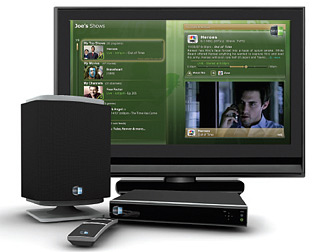'Show Me the DTV Dollars'
ALEXANDRIA, VA.—Sezmi's recent retreat from hybrid broadcast/broadband delivery marks the latest setback in broadcasters' visions for finding new revenue streams in their digital TV spectrum. In the past few years ventures such as USDTV, iBlast and Geocast also couldn't find a sustainable route onto the airwaves, hence failing to deliver new income sources to TV stations.

Last month, Sezmi announced that it would discontinue its consumer services, which never launched beyond its Los Angeles test market. Not that there's no hope for broadcasters' ancillary digital TV channels. More than 2,150 multicast signals are now being beamed out by local TV stations, according to Media Access Pro, the BIA/Kelsey database. While a lot of attention is focused on upcoming services, especially Mobile DTV, stations are pumping out low-key, low-cost secondary and tertiary channels carrying weather reports, really old syndicated TV shows (so old that they're almost all in black-and-white) and a scattering of datacasting and shared-spectrum services.
"There are several opportunities for local television stations to generate revenues from better utilizing their bandwidths," says Mark Fratrik, vice president and chief economist at BIA/Kelsey, a Chantilly, Va.-based research and investment group. He observes that there is a "vast array" of programs, citing as an example, of WKRC-TV in Cincinnati, which carries the CW network as a multicast stream, and, according to Fratrik, it generated an estimated "$4 million in advertising revenue in 2010."
"Yes, that is all from their multicast streaming of CW network programming," he emphasizes.
Similar reports—while scarce—suggest that some broadcasters are finding ways to monetize their DTV bands. As has often been the case in the digital TV era, many public TV broadcasters are leading the way.
For example, KLVX-TV "Vegas PBS" has added more than 25 percent to its overall viewership by programming "Create," lifestyle and how-to programs, on its channel 10.2 and "V-me" Spanish-language programming on channel 10.3. KLVX General Manager Tom Axtell points out that the primary Channel 10.1 attracted a monthly average audience of 446,743 viewers, according to Nielsen's latest report. "Create" drew 79,578 viewers, and V-me had 48,870 people tune in.
Because of its presence in Nevada's convention mecca, the station has been able to experiment with a variety of DTV technologies. "We have made datacasting proposals [that] have included restaurant and show reservation systems in Las Vegas, electronic billboard updates, and electronic messaging in buses," Axtell says. "We have also conducted many demonstrations during the NAB, CTIA and CES shows. Interestingly, the public safety interest has exceeded the commercial interest in the technology."
STILL TRYING TO DATACAST
While public safety applications figure strongly into the promise of DTV bandwidth, countless proposals for use of channels focus on business services.
CMMB Vision Holdings Ltd, through several operating units, is seeking to develop a range of services, including ones that would use Internet protocols to transport streams of existing TV stations. Its primary venture is "Converged Mobile Multimedia Broadcasting," which uses a technology developed in China—and seen there by more than four million mobile viewers, according to Vern Fotheringham, the founder and managing member of CMMB America.
"More than 40 million CMMB chips have been made in China," he says, noting that the open-standard chips cost about the equivalent of $3; he compared that to the mobile DTV chips price of $14 each, suggesting that his approach will "offload the capacity of how consumers watch video." Fotheringham expects that a demonstration system will debut in Virginia by year-end.
Even with such entrepreneurial enthusiasm, there is little agreement on the best approach for broadcasters in the digital multicasting era.
Richard Ducey, chief strategy officer at BIA/Kelsey, acknowledges that there is "no proven success models for anyone other than broadcasters themselves monetizing their own spectrum."
"I'd love to see broadcasters develop their own spectrum with Mobile DTV and some of the new ATSC enhancements for over-the-air and connected services and functionality," Ducey says. "That's where I'd put my money of how broadcasters could further monetize their spectrum and grow the business."
Ducey's former colleague on the NAB staff in the 1990s, John Abel, has entrepreneured several datacasting projects and is more skeptical.
"With bandwidth becoming a commodity, I just do not see how broadcasters can do much in the 'data broadcasting' area," says Abel, who is a partner at Team Lightbulb LLC, a Vienna, Va. professional development firm specializing in broadband and broadcasting. "Their bandwidth is not bidirectional so the networks that they build need to be asymmetrical; their coverage area and building penetration is highly variable, their bandwidth is not very compelling."
Abel also points out that the shifting relationships between stations and networks have affected the introduction of local ancillary channels.
"The broadcast networks were openly telling their affiliates not to 'affiliate' with [Geocast] because they had a plan for how to use their affiliates' spectrum," Abel says, recalling the turndowns he received when trying to persuade stations to carry his local datacasting service. He also repeatedly heard broadcast networks contend that they "already had a claim on all of the digital spectrum of their affiliates."

Richard Ducey While such corporate wrangling stymied past datacasting ventures, an underlying concern—fomented by broadcast attorneys—is the licensing requirement that broadcasters must "control" their spectrum. If TV stations turn over part of their digital spectrum to another entity for video, data, local security or other services, they might run into FCC barriers—an issue that has not yet been fully challenged.
On the other side of that barrier, start-ups seeking to use some of the broadcast bandwidth have often been unable to find funding because investors recognize that the alternative service operator may not actually control the bandwidth of the TV licensee.
"It's a fundamental flaw," says Abel, recalling his Geocast experience. "If you build a data broadcasting business, it could go 'poof' if the broadcasters decide that they have a better way to use that spectrum."
LESSONS FROM OVERSEAS
The alternative airwaves use issue has been a work in progress in the United Kingdom for nearly eight years, since British TV stations began transmitting Freeview services on the bandwidth of Digital Terrestrial TV (DTT) stations. While most ancillary channels from BBC, ITV and Channels 4 and 5 are available as "free to air" services, in 2004, Top Up TV, a subscription-based DTT provider, began leasing unused channel space for premium programming. The basic Freeview programming is supported via the annual TV licenses that Britons must buy (for BBC) and by advertising on the commercial channels.
So far, the U.K. experience is similar to the U.S. process.
Forty percent of British homes are now receiving Freeview programming, according to Carl Hibbert, a research expert at FutureSource Consulting, a U.K. market research firm. "As DVB-T2 tuners become an increasingly standard feature within TV-sets and set-top box price points reduce, the installed base of FTA HD-broadcast ready homes will rise.
"An opportunity for new revenue will come from the introduction of hybrid broadcast/broadband TV delivery solutions such as YouView in the UK and HbbTV in several mainland European countries," Hibbert adds. "Additional advertising revenues will be complemented by the opportunity to create new revenue streams from on-demand services and other applications."
On both sides of the Atlantic, visionaries and broadcast licensees are continuing to explore ways to monetize the bandwidth and serve local customers. The purpose is not just to bring in more revenue. Their success in developing viable applications and content may become a defensive tactic as policy-makers seek reasons to take away spectrum allocations if broadcasters cannot show that they are using their bandwidth to its full value.
Get the TV Tech Newsletter
The professional video industry's #1 source for news, trends and product and tech information. Sign up below.
Gary Arlen, a contributor to Broadcasting & Cable, NextTV and TV Tech, is known for his visionary insights into the convergence of media + telecom + content + technology. His perspectives on public/tech policy, marketing and audience measurement have added to the value of his research and analyses of emerging interactive and broadband services. Gary was founder/editor/publisher of Interactivity Report, TeleServices Report and other influential newsletters; he was the long-time “curmudgeon” columnist for Multichannel News as well as a regular contributor to AdMap, Washington Technology and Telecommunications Reports; Gary writes regularly about trends and media/marketing for the Consumer Technology Association's i3 magazine plus several blogs.

